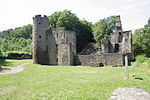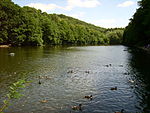Zeche Neuglück & Stettin
Coal mines in GermanyGeography of North Rhine-Westphalia
The Zeche Neuglück & Stettin (Neuglück & Stettin Mine) in Witten-Muttental is a former mine, also known as the Zeche Stettin & Neuglück. It was created in the Stadtforst Mutteltal as a result of the Niemeyersche Karte, where there is now a fire station and is west of today's Berghauser Straße. The Stettin tunnel is now a component of the Bergbauwanderweg Muttental Muttental Mining trail.
Excerpt from the Wikipedia article Zeche Neuglück & Stettin (License: CC BY-SA 3.0, Authors).Zeche Neuglück & Stettin
Berghauser Straße,
Geographical coordinates (GPS) Address Nearby Places Show on map
Geographical coordinates (GPS)
| Latitude | Longitude |
|---|---|
| N 51.412777777778 ° | E 7.3055555555556 ° |
Address
Berghauser Straße
Berghauser Straße
58452 , Herbede
North Rhine-Westphalia, Germany
Open on Google Maps







